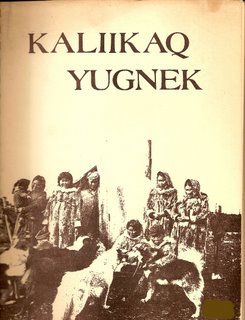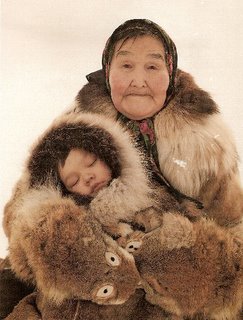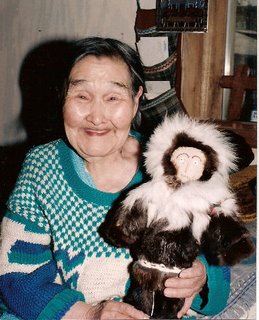Yupik Eskimo Ghost Stories
In southwest
 In my search for information about Yupik ghost stories, my friend Joan loaned me some materials she had from a class on Yupik culture that she took back in the early 1990s. I was immediately drawn to a yellowed, spiral-bound booklet entitled Kaliikaq Yugnek (loosely translated: written stories of the Yupik people). It is a sort of magazine (Volume 2, Number 1) published by the students and teachers of Bethel Regional High School in the fall and winter of 1975. The booklet consists of stories and legends told by village elders, and recorded and translated by the students.
In my search for information about Yupik ghost stories, my friend Joan loaned me some materials she had from a class on Yupik culture that she took back in the early 1990s. I was immediately drawn to a yellowed, spiral-bound booklet entitled Kaliikaq Yugnek (loosely translated: written stories of the Yupik people). It is a sort of magazine (Volume 2, Number 1) published by the students and teachers of Bethel Regional High School in the fall and winter of 1975. The booklet consists of stories and legends told by village elders, and recorded and translated by the students.
I would like to share two of the stories with you. I searched for anyone from whom I might obtain permission to reprint, but as this was over thirty years ago, the editors are long gone. Given the age of the document, I hope that full attribution of the source is adequate. I have done some minor editing for clarity and correction of typographical errors.
The first story is called “Ghosts and Rules” and was told by
She became somewhat famous in
PHOTO COPYRIGHT MYRON ROSENBERG, USED WITH HIS PERMISSION.
She was 69 years old when that photo was taken, holding her great grandson. The second photo of her is one that I took in her home that day; she was 83. She still lives in
Ghosts and Rules
by Lucy Beaver, translated by Janet Kasayuli
My name is Lucy Beaver and I’m 61 years old. I am from Nunapitchuk and now live here in
[A man who experienced this] took care of the image [of the ghost] then goes in the house and right after he goes into the house he gets very sick and starts throwing up lots of green stuff that was very bad. That’s what happens to every person that had the same experience.
###
The second story is told by someone from a different village, but conveys similar beliefs about what to do when you see a ghost.
Seeing a Ghost
by Minnie Carter, translated by Annie Carter
Once upon a time there was a white man who traveled from Quinhagak to Bethel
The white man made tea. The Eskimo didn’t want any tea. After tea, when the Eskimo had eaten and the white man had had his tea, they got warm. They put wood on the camp fire. They got sleepy. When the days got shorter they started getting ready for bed early. Just when they were getting ready for bed they heard something which seemed to crack. It cracked harder at the door. They wondered what it was. The door was shaking and it seemed as though fog was coming around the door. The white man asked, “What is it?” And the Eskimo said the ghost was coming in. The fog went whirling up toward the ceiling. The white man didn’t believe there could be a ghost coming. On the floor, the grasses (grass mats used as floor coverings) stood up, even though the white man and the Eskimo stood on them, pinning them to the ground. The grasses stood straight up on the floor. The door had not opened when the ghost came in; it came in at the bottom of the door. The ghost came in all white, his face was covered with something like leather, like muskrat on an old parka. The ghost came in all the way. The white man got scared and started running in the house. He was crying in the house, running around trying to get out, but the door could not be opened. The white man went over beside the Eskimo, and the Eskimo tried to think of what to do. The ghost was coming and the Eskimo stood up very fast. While this was going on they were afraid that the ghost might kill them by whirling them like a bome [ed. note: ? ... no idea]. Then the Eskimo went right over to the ghost as he used to hear was the right thing to do with ghosts and put his hand on the ghost’s neck and it felt very cold, it was like the ashes from a burned wood fire, and as he had heard about ghosts, he put his hand on the ghost’s head. Then the ghost started going down under the ground, disappearing. When the Eskimo thought he’d try to push it harder, the ghost came back up a little. The ghost disappeared into the ground and the ground where the ghost disappeared was whirling. The Eskimo remembered that he used to hear stories about what to do about ghosts so he used his mukluks to step on the whirling ground and it stopped whirling. The grass mats on the ground that had stood up fell to the ground and the white man took the grasses and threw them outside very fast.
They started getting ready to go. They packed their bags. They packed their sleds and didn’t put out the campfire. They left the dogs ready to go when they went in the house. They didn’t want to waste time getting the dogsled ready.
They traveled not too far from where the graves were. Then the white man patted the Eskimo on the back and told him to look behind. It looked like a sun, a really red ball was following them. The Eskimo took out his knife and put marks on the snow crossways. They continued traveling. The red fire ball got to those marks and started sinking into the ground.
They started to get sick before they got to the
They were well the next day. They left and got to Napakiak safely. They were still scared and were really looking out for ghosts. Even though it was in the day time, they were scared.
###
This little booklet is a treasure trove of Yupik culture, and I am delighted to have come across it. Many thanks to Joan for sharing it with me. And a happy Halloween to one and all! May the spirits of your ancestors be pleased with you...
Labels: Tundra Life






11 Comments:
These are both great stories, so appropriate for today. You made a big mistake tho' when you didn't get a doll--better rush right out and make it right. I hope you can circulate the story in the schools, or maybe they can pick it up from the internet?
Not only is your blog fascinating to read regarding health care in Alaska and the lifestyle there, but your deep respect and admiration for the Yupik people is very clear. Sharing stories such as these helps the rest of us to appreciate this ancient culture. Thank you.
People from any culture could identify with these stories. I would love to hear these traditional oral stories told around a fire. A child would not venture out of bed for anything at all...probably what the adults wanted. These are much more creative than the average slasher horror flick story line.
How facinating!!! I love seeing things like that that share history and culture so that it isn't lost...thank you for sharing.
Neat post!
Borneo--your comment reminds me that I've been meaning to do a post on my Yupik doll collection, with photos, of course! I do with I had purchased one of Lucy's dolls that day. They are all gone now, and she hasn't been able to sew for years, due to failing eyesight and arthritic hands. I treasure the beautiful mukluks and fur hat that she made.
Sharon--thank you so much! I am glad that people enjoy the stories I write about this amazing place. The culture here has enriched my life immeasureably, and I am happy to share it with those who are interested.
Ruth--these ghost stories appeal to me too; I'm just not a slasher horror flick kinda gal!
Wolfbaby and bohemian r.n.--glad you liked it; thanks for stopping in.
Lucy rocks! You can read her entire personality in her face. How wonderful for you that you have been able to know her!
Great stories, thank you for sharing them!
These are great stories... but if Lucy is still alive, you might have asked her for permission to post her story!
This story is old, but is very
good. A lot of people still don't take things from grave sights no more because of similar storys.
Hey! The Teakettle Ghost! I love this story. It is by my Great-Grandmother from Eek. I have a VHS of her telling this story in Yupik. Thanks for posting it!
Mike McIntyre
Hello. My mom is Janet Kasayuli. I am going to share this story with her and see if she remembers. :)
Post a Comment
<< Home